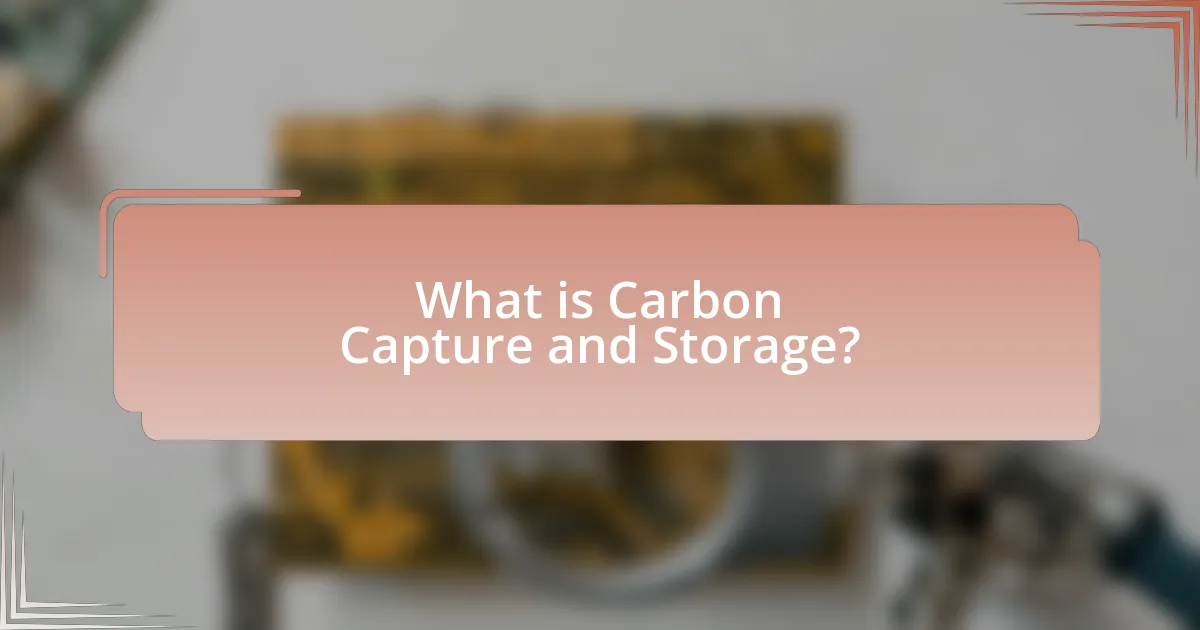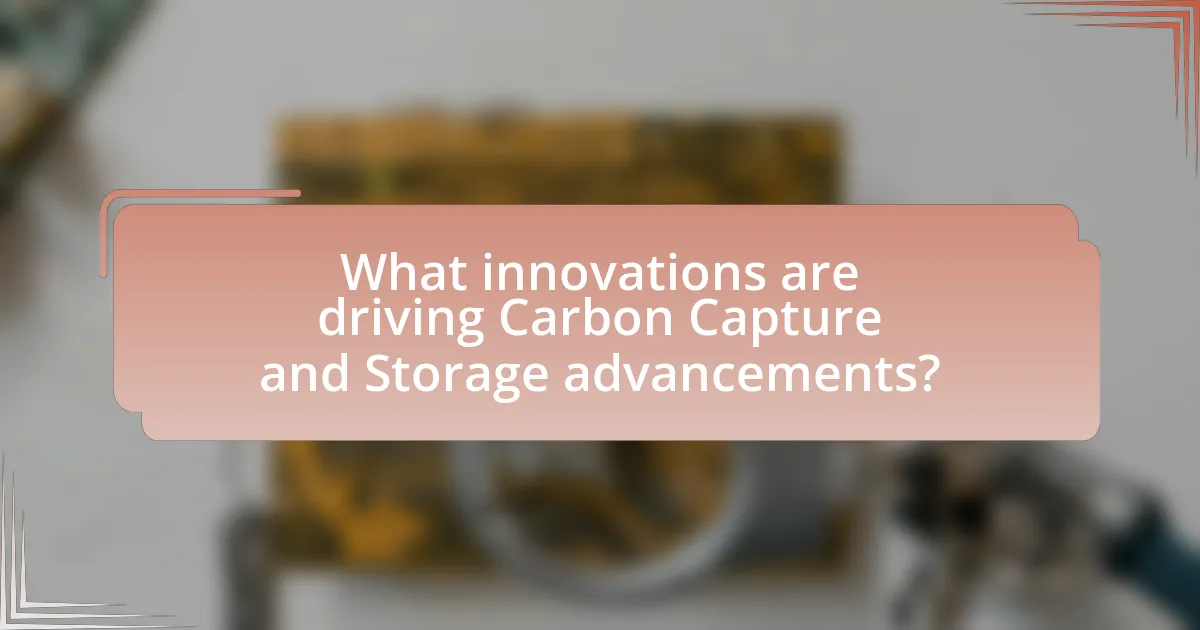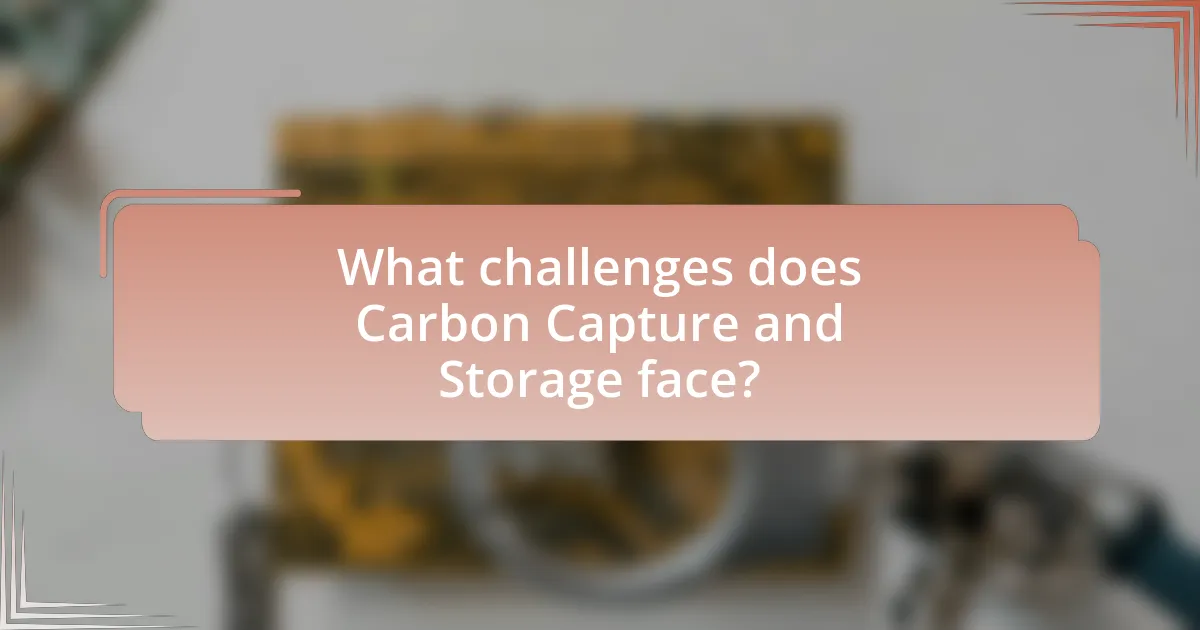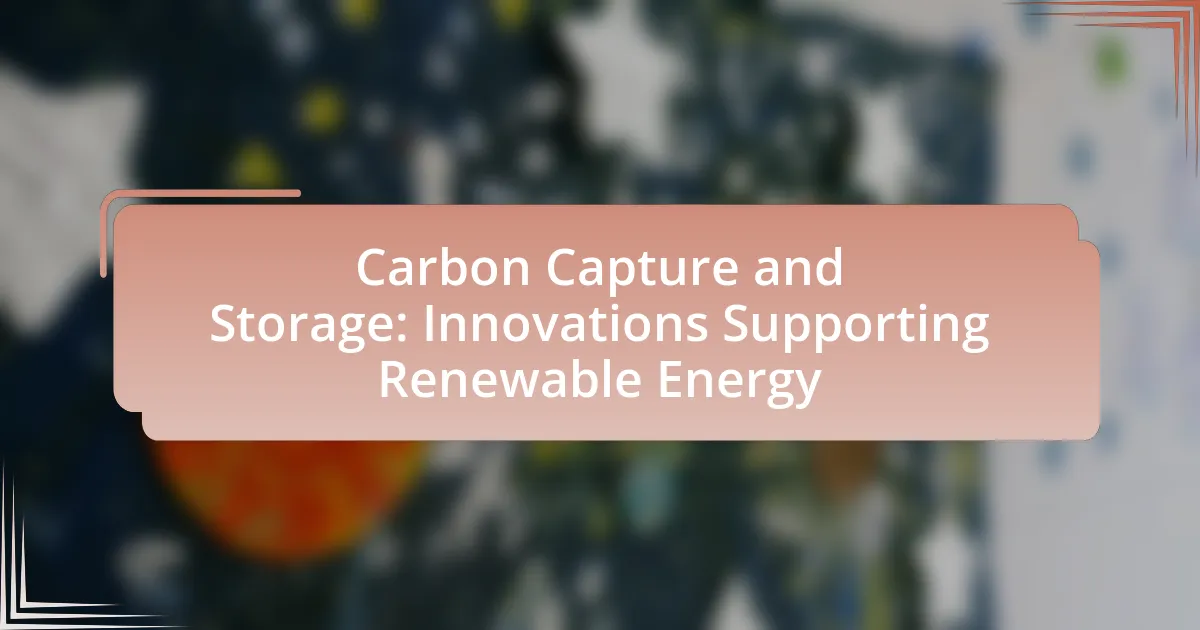Carbon Capture and Storage (CCS) is a critical technology aimed at reducing carbon dioxide emissions from fossil fuel use in electricity generation and industrial processes. The article outlines the functioning of CCS, including the capture, transportation, and safe underground storage of CO2, and highlights key technologies such as post-combustion and pre-combustion capture. It emphasizes the importance of CCS in mitigating climate change, supporting renewable energy integration, and discusses innovations that enhance capture efficiency and storage safety. Additionally, the article addresses economic implications, funding opportunities, challenges, and best practices for implementing CCS, providing a comprehensive overview of its role in achieving global emissions reduction targets.

What is Carbon Capture and Storage?
Carbon Capture and Storage (CCS) is a technology designed to capture carbon dioxide emissions produced from the use of fossil fuels in electricity generation and industrial processes, preventing the gas from entering the atmosphere. The captured carbon dioxide is then transported and stored underground in geological formations, such as depleted oil and gas fields or deep saline aquifers, effectively reducing greenhouse gas emissions. According to the International Energy Agency, CCS could contribute to up to 14% of the global emissions reduction needed by 2050 to limit climate change.
How does Carbon Capture and Storage function?
Carbon Capture and Storage (CCS) functions by capturing carbon dioxide emissions from sources like power plants and industrial processes, transporting the captured CO2, and storing it underground in geological formations. The process begins with the capture phase, where technologies such as absorption, adsorption, or membrane separation are used to isolate CO2 from other gases. Once captured, the CO2 is compressed and transported, typically via pipelines, to a storage site. Finally, the CO2 is injected into deep geological formations, such as depleted oil and gas fields or deep saline aquifers, where it can be securely stored for long periods, preventing its release into the atmosphere. This method is supported by research indicating that geological formations can safely contain CO2 for thousands of years, thus contributing to climate change mitigation efforts.
What are the key technologies used in Carbon Capture?
The key technologies used in carbon capture include post-combustion capture, pre-combustion capture, and oxy-fuel combustion. Post-combustion capture involves removing CO2 from flue gases after fossil fuels are burned, utilizing solvents like amines to absorb carbon dioxide. Pre-combustion capture occurs before combustion, converting fossil fuels into a mixture of hydrogen and CO2, allowing for CO2 to be separated before burning. Oxy-fuel combustion uses pure oxygen instead of air for combustion, resulting in a flue gas that is primarily water vapor and CO2, making it easier to capture the carbon dioxide. These technologies are essential for reducing greenhouse gas emissions and are supported by various research initiatives and pilot projects worldwide.
How is captured carbon stored safely?
Captured carbon is stored safely through methods such as geological sequestration, where carbon dioxide is injected into deep underground rock formations. This process involves selecting stable geological sites, typically at depths greater than 800 meters, where the pressure and temperature conditions allow for the carbon dioxide to remain in a supercritical state, preventing it from escaping. According to the Intergovernmental Panel on Climate Change (IPCC), geological storage has the potential to store billions of tons of carbon dioxide securely over long periods, with monitoring systems in place to ensure containment and detect any potential leaks.
Why is Carbon Capture and Storage important for renewable energy?
Carbon Capture and Storage (CCS) is important for renewable energy because it mitigates greenhouse gas emissions from energy production, enhancing the sustainability of renewable sources. By capturing carbon dioxide emissions from fossil fuel power plants and industrial processes, CCS prevents significant amounts of CO2 from entering the atmosphere, which is crucial for combating climate change. According to the International Energy Agency, CCS could contribute to 14% of the global emissions reduction needed by 2050 to limit global warming to 2 degrees Celsius. This integration of CCS with renewable energy systems allows for a more balanced energy transition, ensuring that while renewable technologies are developed, existing fossil fuel infrastructures can be utilized more sustainably.
What role does Carbon Capture play in reducing emissions?
Carbon capture plays a crucial role in reducing emissions by capturing carbon dioxide (CO2) produced from industrial processes and energy generation before it enters the atmosphere. This technology can significantly lower greenhouse gas emissions, with studies indicating that carbon capture and storage (CCS) could contribute to a reduction of up to 14% of global CO2 emissions by 2050. By preventing CO2 from being released, carbon capture helps mitigate climate change and supports the transition to a low-carbon economy.
How does Carbon Capture support the transition to renewable energy sources?
Carbon capture supports the transition to renewable energy sources by reducing greenhouse gas emissions from fossil fuel use, thereby facilitating a cleaner energy landscape. By capturing carbon dioxide emissions from power plants and industrial processes, carbon capture technology allows for the continued use of existing infrastructure while minimizing environmental impact. This technology can be integrated with renewable energy systems, such as bioenergy with carbon capture and storage (BECCS), which not only generates energy but also removes CO2 from the atmosphere. According to the Intergovernmental Panel on Climate Change (IPCC), achieving net-zero emissions by 2050 will require significant deployment of carbon capture technologies alongside renewable energy sources to effectively mitigate climate change.

What innovations are driving Carbon Capture and Storage advancements?
Innovations driving Carbon Capture and Storage (CCS) advancements include the development of more efficient capture technologies, such as direct air capture and advanced solvent systems. Direct air capture technologies, like those developed by companies such as Climeworks, utilize chemical processes to extract CO2 directly from the atmosphere, demonstrating a significant reduction in energy consumption compared to traditional methods. Advanced solvent systems, which involve new materials that can absorb CO2 more effectively, have been shown to increase capture efficiency by up to 30%, as evidenced by research from the National Renewable Energy Laboratory. Additionally, innovations in storage techniques, such as mineralization and geological sequestration, are enhancing the safety and permanence of CO2 storage, with studies indicating that mineralization can permanently store CO2 in solid form, reducing the risk of leakage. These advancements collectively contribute to the effectiveness and viability of CCS as a critical technology in mitigating climate change.
How are new technologies enhancing Carbon Capture efficiency?
New technologies are enhancing Carbon Capture efficiency by utilizing advanced materials and processes that improve absorption rates and reduce energy consumption. For instance, innovations in sorbent materials, such as metal-organic frameworks (MOFs), have demonstrated significantly higher CO2 capture capacities compared to traditional amine-based solvents, achieving efficiencies of up to 90% in laboratory settings. Additionally, the integration of machine learning algorithms in carbon capture systems optimizes operational parameters in real-time, leading to more efficient capture processes and reduced costs. These advancements collectively contribute to a more effective and economically viable carbon capture framework, supporting the broader goals of renewable energy initiatives.
What are the latest developments in Carbon Capture materials?
Recent advancements in carbon capture materials include the development of metal-organic frameworks (MOFs) and advanced sorbents that enhance CO2 adsorption efficiency. For instance, researchers have created new MOFs that can capture CO2 at lower energy costs and higher capacities, such as those reported in a study published in Nature Communications, which demonstrated a 30% increase in CO2 uptake compared to previous materials. Additionally, innovations in polymer-based sorbents have shown promise, with some materials achieving rapid CO2 capture and release cycles, making them suitable for industrial applications. These developments are crucial for improving the overall efficiency and viability of carbon capture technologies in mitigating climate change.
How do innovative processes improve carbon storage methods?
Innovative processes enhance carbon storage methods by utilizing advanced technologies and materials that increase efficiency and capacity for carbon dioxide sequestration. For instance, the development of novel sorbents and membranes allows for more effective capture of CO2 from industrial emissions, significantly improving the overall carbon capture rate. Research indicates that using metal-organic frameworks (MOFs) can increase CO2 adsorption capacities by up to 10 times compared to traditional methods, thereby optimizing storage potential. Additionally, innovations in geological storage techniques, such as enhanced oil recovery (EOR), not only sequester carbon but also improve oil extraction efficiency, demonstrating a dual benefit. These advancements collectively contribute to more sustainable and effective carbon storage solutions, aligning with global climate goals.
What are the economic implications of Carbon Capture innovations?
Carbon capture innovations have significant economic implications, primarily by reducing the costs associated with climate change and enabling new revenue streams. These technologies can lower greenhouse gas emissions from industrial processes, which in turn can help companies avoid carbon taxes and comply with regulatory requirements, potentially saving billions in penalties. For instance, the Global CCS Institute reported that implementing carbon capture could lead to a reduction in the cost of achieving climate targets by up to 70% compared to traditional methods. Additionally, carbon capture can create job opportunities in engineering, manufacturing, and maintenance sectors, contributing to economic growth. The International Energy Agency estimates that the deployment of carbon capture technologies could generate over 200,000 jobs by 2030. Overall, carbon capture innovations not only mitigate environmental impacts but also foster economic resilience and growth.
How do these innovations affect the cost of renewable energy?
Innovations in carbon capture and storage (CCS) significantly reduce the cost of renewable energy by enhancing efficiency and enabling the integration of renewables with fossil fuel systems. For instance, advancements in CCS technologies can capture up to 90% of carbon emissions from power plants, which allows for a more sustainable use of existing fossil fuel infrastructure while transitioning to renewable sources. According to a report by the International Energy Agency, the cost of capturing carbon has decreased by 30% over the past decade due to technological improvements and economies of scale. This reduction in costs makes renewable energy sources more competitive in the energy market, ultimately leading to lower prices for consumers and increased adoption of clean energy technologies.
What funding opportunities exist for Carbon Capture projects?
Funding opportunities for Carbon Capture projects include government grants, private investments, and international climate funds. For instance, the U.S. Department of Energy offers funding through the Carbon Capture, Utilization, and Storage (CCUS) program, which has allocated billions in recent years to support innovative technologies. Additionally, the European Union has established the Innovation Fund, which provides financial support for large-scale carbon capture projects as part of its Green Deal initiative. Furthermore, private sector investments from companies focused on sustainability and carbon neutrality are increasingly directed towards carbon capture technologies, reflecting a growing recognition of their importance in mitigating climate change.

What challenges does Carbon Capture and Storage face?
Carbon Capture and Storage (CCS) faces several significant challenges, including high costs, technological limitations, and regulatory hurdles. The financial aspect is critical, as the implementation of CCS technology can require substantial investment, often exceeding billions of dollars for large-scale projects. For instance, the International Energy Agency estimates that the cost of capturing CO2 can range from $50 to $100 per ton, which can be prohibitive for many industries.
Technologically, CCS is still developing, with issues related to the efficiency of capture processes and the long-term storage of CO2. Current methods may not capture all emissions, and there are concerns about the potential leakage of stored CO2, which could undermine the effectiveness of the technology.
Regulatory challenges also pose a barrier, as there is often a lack of clear policies and frameworks governing the deployment of CCS. This uncertainty can deter investment and slow down the adoption of CCS technologies. Overall, these challenges must be addressed to enhance the viability and effectiveness of Carbon Capture and Storage in mitigating climate change.
What are the technical barriers to widespread adoption?
The technical barriers to widespread adoption of carbon capture and storage (CCS) include high costs, limited infrastructure, and technological challenges. High costs arise from the expensive nature of capturing, transporting, and storing carbon dioxide, which can deter investment and implementation. Limited infrastructure is a significant barrier, as existing pipelines and storage sites are insufficient to support large-scale CCS deployment. Technological challenges also persist, including the need for more efficient capture technologies and reliable monitoring systems to ensure the safety and effectiveness of storage sites. These barriers collectively hinder the scalability and integration of CCS into existing energy systems.
How do regulatory frameworks impact Carbon Capture initiatives?
Regulatory frameworks significantly influence Carbon Capture initiatives by establishing guidelines, incentives, and penalties that shape the development and implementation of these technologies. For instance, supportive regulations can provide financial incentives, such as tax credits or grants, which encourage investment in carbon capture projects. The U.S. 45Q tax credit, which offers financial benefits for capturing and storing carbon dioxide, exemplifies how regulatory measures can stimulate industry growth. Conversely, stringent regulations may impose compliance costs that can hinder project feasibility. Therefore, the nature of regulatory frameworks directly affects the pace and scale of carbon capture deployment, as evidenced by varying levels of investment and innovation across regions with different regulatory environments.
What public perceptions influence Carbon Capture acceptance?
Public perceptions that influence Carbon Capture acceptance include concerns about environmental effectiveness, economic viability, and trust in technology. Research indicates that individuals are more likely to support Carbon Capture initiatives when they believe these technologies can significantly reduce greenhouse gas emissions and contribute to climate change mitigation. A survey conducted by the International Energy Agency found that 70% of respondents expressed support for Carbon Capture when informed about its potential to lower carbon emissions from industrial sources. Additionally, perceptions of economic benefits, such as job creation in the green technology sector, enhance acceptance. Trust in the institutions promoting Carbon Capture also plays a crucial role; studies show that public confidence in government and scientific organizations correlates with higher acceptance rates of Carbon Capture projects.
How can these challenges be overcome?
To overcome the challenges of carbon capture and storage (CCS), advancements in technology and policy frameworks are essential. Implementing innovative capture methods, such as direct air capture and bioenergy with carbon capture and storage (BECCS), can significantly enhance efficiency and reduce costs. For instance, a study by the International Energy Agency indicates that improving capture efficiency could lower costs by up to 30% by 2030. Additionally, establishing supportive regulatory environments and financial incentives can encourage investment in CCS projects, facilitating broader adoption. Research from the Global CCS Institute highlights that countries with clear policy frameworks have seen a higher rate of CCS deployment, demonstrating the importance of government support in overcoming these challenges.
What strategies are being implemented to enhance public awareness?
Strategies being implemented to enhance public awareness of carbon capture and storage include educational campaigns, community engagement initiatives, and partnerships with media organizations. Educational campaigns aim to inform the public about the benefits and technologies of carbon capture, utilizing workshops, webinars, and informational materials. Community engagement initiatives involve local events and discussions to foster dialogue and address concerns directly with stakeholders. Partnerships with media organizations help disseminate accurate information through news articles, documentaries, and social media, reaching a broader audience. These strategies collectively aim to improve understanding and acceptance of carbon capture technologies, which are crucial for advancing renewable energy efforts.
How can collaboration between sectors improve Carbon Capture outcomes?
Collaboration between sectors can significantly improve Carbon Capture outcomes by leveraging diverse expertise, resources, and technologies. For instance, partnerships between the energy sector and research institutions can accelerate the development of more efficient carbon capture technologies, as evidenced by projects like the Carbon Capture and Storage Association’s initiatives, which have shown that cross-sector collaboration can lead to innovative solutions and reduced costs. Additionally, integrating insights from the industrial sector can enhance the scalability of carbon capture systems, as demonstrated by the collaboration between oil and gas companies and environmental organizations, which has resulted in successful pilot projects that capture millions of tons of CO2 annually. This multifaceted approach not only fosters innovation but also facilitates the sharing of best practices, ultimately leading to more effective and widespread implementation of carbon capture technologies.
What are best practices for implementing Carbon Capture and Storage?
Best practices for implementing Carbon Capture and Storage (CCS) include conducting thorough site assessments, ensuring regulatory compliance, and utilizing advanced monitoring technologies. Site assessments involve evaluating geological formations for their capacity to securely store CO2, which is critical for preventing leakage. Regulatory compliance ensures that CCS projects meet environmental standards and safety protocols, fostering public trust and support. Advanced monitoring technologies, such as satellite imaging and seismic surveys, are essential for tracking CO2 movement and verifying storage integrity. These practices are supported by successful CCS projects, such as the Sleipner project in Norway, which has safely stored over 1 million tons of CO2 annually since 1996, demonstrating the effectiveness of these best practices in real-world applications.
How can organizations effectively integrate Carbon Capture technologies?
Organizations can effectively integrate Carbon Capture technologies by adopting a systematic approach that includes assessing their carbon emissions, selecting appropriate capture technologies, and investing in infrastructure. First, organizations should conduct a comprehensive carbon footprint analysis to identify major sources of emissions, which allows for targeted implementation of capture solutions. Next, they can choose from various technologies such as post-combustion capture, pre-combustion capture, or direct air capture, depending on their specific operational needs and emission profiles.
Investment in necessary infrastructure, including pipelines for transporting captured CO2 and storage facilities, is crucial for successful integration. For instance, the Global CCS Institute reports that over 26 million tons of CO2 were captured in 2020, demonstrating the viability and scalability of these technologies. Furthermore, collaboration with governmental bodies and participation in carbon credit markets can enhance financial viability and support long-term sustainability goals.
What lessons have been learned from existing Carbon Capture projects?
Existing Carbon Capture projects have demonstrated that scalability and cost-effectiveness are critical for widespread adoption. For instance, the Petra Nova project in Texas, which captures over 1.6 million tons of CO2 annually, highlighted the importance of integrating carbon capture with existing infrastructure to enhance economic viability. Additionally, lessons from the Boundary Dam project in Canada revealed that operational efficiency can be improved through continuous monitoring and optimization of capture technologies. These projects also underscored the necessity of regulatory frameworks and public acceptance to facilitate investment and development in carbon capture technologies.


